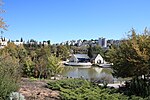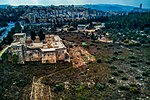Neve Granot
Neighbourhoods of Jerusalem
Neve Granot is a neighborhood in Jerusalem located behind the Israel Museum, overlooking the Monastery of the Cross. Neve Granot is named for Avraham Granot, a Zionist activist and signatory of the Israeli Declaration of Independence who went on to become head of the Jewish National Fund. The Schechter Institute of Jewish Studies in Neve Granot built its new campus there, designed by Israeli architect Ada Carmi.
Excerpt from the Wikipedia article Neve Granot (License: CC BY-SA 3.0, Authors).Neve Granot
Davidson, Jerusalem Nayot
Geographical coordinates (GPS) Address Nearby Places Show on map
Geographical coordinates (GPS)
| Latitude | Longitude |
|---|---|
| N 31.769677777778 ° | E 35.204358333333 ° |
Address
Davidson 8
9218812 Jerusalem, Nayot
Jerusalem District, Israel
Open on Google Maps










